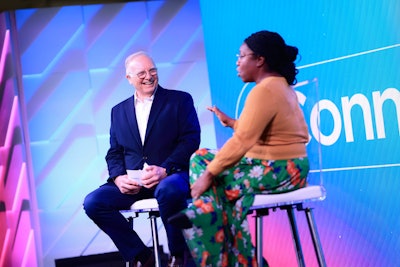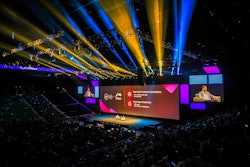
“I've always believed that the true value of a conference extends far beyond the event itself,” says Michał Kierul, CEO of INTechHouse, who describes events as "a wellspring of content." "[Repurposing content] allows us to maintain engagement with our audience, turning a single event into a lasting conversation."
Adam Hardingham, CEO of digital marketing agency Rivmedia, agrees. “Think of your event as a gold mine, not a one-hit wonder,” he advises when asked how repurposing content can help amplify an event's reach and also reinforce its value proposition year-round.
Here are some of the most popular—and effective—ways to repurpose content:
On-Demand Libraries
Rather than just being a collection of event recordings (but that’s great too!), on-demand libraries can increase engagement with behind-the-scenes clips, interviews with attendees and speakers, and interactive moments. “It's like a Netflix for attendees, extending the learning and networking,” notes Hardingham.
Gianluca Ferruggia, general manager of B2B marketplace DesignRush, also leans into content hubs. “By making our event content available on demand, we are able to cater to a global audience, providing access to valuable insights anytime, anywhere,” he notes. “This approach broadens our audience base and enhances the value of our content over time, turning a single event into a continuous source of engagement and learning.”
Podcasts
Speakers may have limited time onstage—but inviting them for a more in-depth conversation can make the content more intriguing and accessible for a wider audience, and help you get the most bang for your buck with speaker hires. Even repackaging keynotes or panel discussions into podcast episodes can help extend an event’s influence.
“Podcasts have been a wonderful choice for repurposing event content. It helps to amplify your voice and reach more people who are interested in the topic or theme of your event," explains marketing strategist and wedding expert Carissa Kruse.
Social Media
Social media is, of course, one of the most popular ways to repurpose content year-round. “My approach involves carefully selecting snippets from conferences that are both insightful and captivating," says Kierul. "I then repurpose this content across different platforms, each tailored to its unique audience. For example, professional insights find a place on LinkedIn, while Instagram is perfect for more visually appealing moments."
One easy-to-implement strategy Kierul likes is #ThrowbackThursday posts. "These posts not only evoke fond memories of the event but also serve as a medium to revisit and highlight key moments. This ensures that the content stays relevant and continues to engage the audience, keeping the dialogue alive and the community engaged.”
Highlight Reels and Future Event Promotions
“Highlight reels and promotional videos are powerful tools to showcase the best of what our events offer," explains Ferruggia. "By focusing on the most engaging and impactful moments, we craft narratives that not only capture the essence of past events but also generate excitement for future ones.”
Kruse recalls an event where her team recorded all panel discussions and keynote speeches. "We repurposed these recordings into highlight reels and shared them on social media, generating over 10,000 views. It was a great way to keep the event alive even after it had ended.”
Blog Posts, Newsletters, and Event Summaries
Share highlights via newsletters and email marketing campaigns, or use photos and presentations to create website content (one of BizBash's own go-to methods). “Summarizing themes as infographics or turning panels into blog posts helps optimize discussions for digital spaces,” suggests Alison Lancaster, co-founder of PR agency Pressat.
“Focus on the key takeaways and insights from the event," adds Mocca Bajao, a digital PR strategist at Thrive Internet Marketing Agency. "Create a summary or cheat sheet with this information and distribute it to your audience via email or social media. This will remind attendees of what they learned at the event and provide valuable information for those who couldn't attend.”
Our experts also shared some best practices to keep in mind.
1. Make a plan before the event begins.
“The key is planning, repurposing early, and recording quality source materials,” notes Lancaster. “I advise mapping which formats suit each message and channel before the event. It's also important to transcribe so you have written content. Focusing on evergreen topics while also flagging trends keeps content fresh over the long haul. Proper planning ensures you capture valuable discussions without disrupting the live event flow.”
2. Afterward, step back and take a full inventory of what you have.
“Analyze what you have," says Bajao. "Take a look at all the materials from your past events—presentations, recordings, photos, social media posts, etc. Then, think about how you can use them in different formats to create new and engaging content.”
3. Keep your event’s key goals and audience in mind.
Any repurposed content should fit into your overall marketing and brand strategy, and the key messages and target audiences of the original event. Maintaining consistent branding can reinforce your event’s identity. In short: Be strategic. “Plan your repurposing strategy before the event, not after,” says Hardingham. “Capture the right materials and anticipate different avenues.”
4. Schedule strategically.
Strategic scheduling is key. Distributing content throughout the year keeps your audience continuously engaged. Consider building out a content calendar to plan and organize these posts, ensuring a steady stream of content.
5. Tailor content to best suit each platform.
Be intentional about the content you're choosing—and how you're using it. "Repurpose the gold, not the coal. Prioritize valuable content and polish it for different formats," says Hardingham, emphasizing the importance of knowing your audience. “Tailor repurposed content to their preferred channels and consumption habits.”
Sarah Quinlivan, owner and lead planner of Quintessential Events, adds: “For TikTok and Instagram Reels, we use more of the behind-the-scenes content that our team captures. For our website, advertisements, and proposals, we heavily lean on the professional images and video captured."
6. Shout out your collaborators.
“No matter where we post content, any vendor involved in that shot is tagged," adds Quinlivan. "Tagging and sharing content with the other vendors is a huge way to grow our reach and audience. More importantly, it allows us to be a true teammate with our fellow vendors. No event is possible without a great team!”
7. Make it creative and interactive.
Encourage your audience to interact with your content through Q&A sessions, online discussions, or feedback surveys. This not only increases engagement but also provides valuable insights into your audience’s preferences. “Don't just transcribe talks. Inject creativity!" says Hardingham. "Adapt content to the chosen format for maximum engagement."
8. Avoid overusing the same content.
“Be selective and strategic in repurposing content,” suggests Ferruggia. “Every event won't fit every platform, and bombarding the audience with too much content can lead to disengagement. Tailor your content to make sure that it truly adds value.”
Lancaster often sees clients trying to repurpose content too similarly across channels—without optimizing the format to the audience. "Spreading yourself too thin can lead to fatigue," she notes. "It's also important not to compromise quality when reformatting. The repurposed piece should still provide value on its own."
9. Track engagement.
Track metrics like engagement rates, website traffic, and conversion rates to understand what resonates with your audience—and refine your strategy accordingly.
Lancaster sums it up with a hopeful anecdote: “One client who mastered these strategies generated a huge return from a one-day conference," she remembers. "By carefully crafting repurposed assets, they increased event leads by over 200%, and are still generating engagement a year later."
She adds, "Time and care spent in the planning and execution really pays off over the long run for audiences and business objectives alike. Effective content repurposing is an art—but with diligence, it can significantly extend the value and impact of your events.”



















